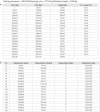GC-Profile: a web-based tool for visualizing and analyzing the variation of GC content in genomic sequences
- PMID: 16845098
- PMCID: PMC1538862
- DOI: 10.1093/nar/gkl040
GC-Profile: a web-based tool for visualizing and analyzing the variation of GC content in genomic sequences
Abstract
In order to understand the evolution, structure and function of genomes, it is important to know the general compositional features of DNA sequences. Based on the quadratic divergence, a new segmentation algorithm to partition a given genome or DNA sequence into compositionally distinct domains has been put forward. With the aid of the technique of cumulative GC profile, the distribution of segmentation points can be displayed intuitively. We have therefore developed them into GC-Profile, an interactive web-based software system, which can be used to segment prokaryotic and eukaryotic genomes. GC-Profile provides a quantitative and qualitative view of genome organization. Based on the obtained results, the relationships between the G+C content and other genomic features, such as distributions of genes and CpG islands, can be analyzed in a perceivable manner. It shows that GC-Profile would be an appropriate starting point for analyzing the isochore structure of higher eukaryotic genomes, and an intuitive tool for identifying genomic islands in prokaryotic genomes. GC-Profile is freely available at the website http://tubic.tju.edu.cn/GC-Profile/. In addition, precompiled binaries, together with examples and documentation, can also be freely downloaded for a local execution.
Figures



Similar articles
-
Isochore structures in the chicken genome.FEBS J. 2006 Apr;273(8):1637-48. doi: 10.1111/j.1742-4658.2006.05178.x. FEBS J. 2006. PMID: 16623701
-
TICO: a tool for postprocessing the predictions of prokaryotic translation initiation sites.Nucleic Acids Res. 2006 Jul 1;34(Web Server issue):W588-90. doi: 10.1093/nar/gkl313. Nucleic Acids Res. 2006. PMID: 16845076 Free PMC article.
-
CorGen--measuring and generating long-range correlations for DNA sequence analysis.Nucleic Acids Res. 2006 Jul 1;34(Web Server issue):W692-5. doi: 10.1093/nar/gkl234. Nucleic Acids Res. 2006. PMID: 16845099 Free PMC article.
-
Visualization of sequence and structural features of genomes and chromosome fragments. Application to CpG islands, Alu sequences and whole genomes.Gene. 2011 Mar 1;473(2):76-81. doi: 10.1016/j.gene.2010.11.008. Epub 2010 Dec 16. Gene. 2011. PMID: 21167919 Review.
-
Isochores and the evolutionary genomics of vertebrates.Gene. 2000 Jan 4;241(1):3-17. doi: 10.1016/s0378-1119(99)00485-0. Gene. 2000. PMID: 10607893 Review.
Cited by
-
Sulfobacillus thermotolerans: new insights into resistance and metabolic capacities of acidophilic chemolithotrophs.Sci Rep. 2019 Oct 21;9(1):15069. doi: 10.1038/s41598-019-51486-1. Sci Rep. 2019. PMID: 31636299 Free PMC article.
-
Deciphering heterogeneity in pig genome assembly Sscrofa9 by isochore and isochore-like region analyses.PLoS One. 2010 Oct 11;5(10):e13303. doi: 10.1371/journal.pone.0013303. PLoS One. 2010. PMID: 20948965 Free PMC article.
-
Novel Tn4371-ICE like element in Ralstonia pickettii and genome mining for comparative elements.BMC Microbiol. 2009 Nov 26;9:242. doi: 10.1186/1471-2180-9-242. BMC Microbiol. 2009. PMID: 19941653 Free PMC article.
-
Haloquadratum walsbyi: limited diversity in a global pond.PLoS One. 2011;6(6):e20968. doi: 10.1371/journal.pone.0020968. Epub 2011 Jun 20. PLoS One. 2011. PMID: 21701686 Free PMC article.
-
Insights into functional and evolutionary analysis of carbaryl metabolic pathway from Pseudomonas sp. strain C5pp.Sci Rep. 2016 Dec 7;6:38430. doi: 10.1038/srep38430. Sci Rep. 2016. PMID: 27924916 Free PMC article.
References
-
- Lobry J.R. A simple vectorial representation of DNA sequences for the detection of replication origins in bacteria. Biochimie. 1996;78:323–326. - PubMed
-
- Zhang R., Zhang C.T. A systematic method to identify genomic islands and its applications in analyzing the genomes of Corynebacterium glutamicum and Vibrio vulnificus CMCP6 chromosome I. Bioinformatics. 2004;20:612–622. - PubMed
-
- Oliver J.L., Bernaola-Galvan P., Carpena P., Roman-Roldan R. Isochore chromosome maps of eukaryotic genomes. Gene. 2001;276:47–56. - PubMed
-
- Li W., Bernaola-Galvan P., Haghighi F., Grosse I. Applications of recursive segmentation to the analysis of DNA sequences. Comput. Chem. 2002;26:491–510. - PubMed
Publication types
MeSH terms
Substances
LinkOut - more resources
Full Text Sources
Other Literature Sources
Miscellaneous

